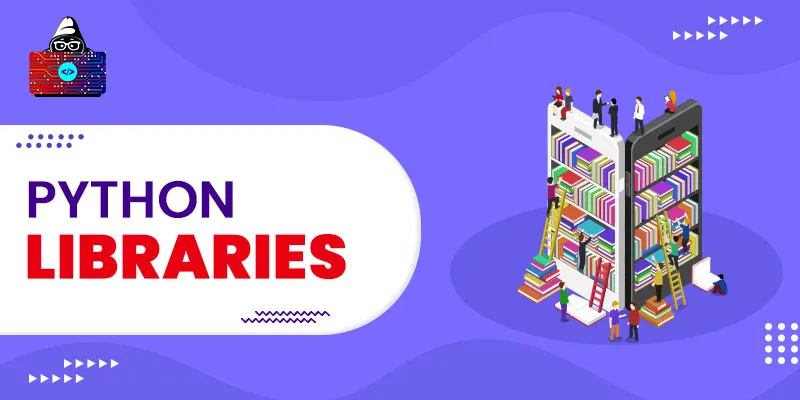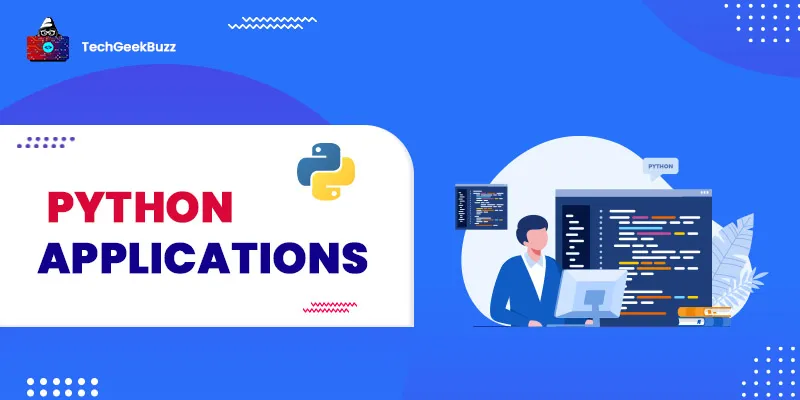Python is one of the trending programming languages with rapid growth in Artificial Intelligence and Machine learning python has gained too much popularity in the past few years. Python's popularity is not only because it is used in Machine learning or data science, but it also has an insane number of libraries that opens the use of Python for any development.
Some famous use cases of Python are web development, scripting, game development, Data Science, and many others. Its simple syntax helps developers to implement complex algorithms with ease.
This article lists the top 10 Python libraries heating the developer community and trending domains like AI, ML, Data Science, and many more.
What is a Library?
A library is a collection of pre-written code that you can import into your code to add some extra functionality. We use libraries, so we do not have to write code from scratch. Instead, we use a library to use the pre-written code, functions, or classes and their functionality to enhance our code.
Python has many libraries, and for different development, we have different libraries in Python. All the libraries we have provided here belong to the Python 3 version because Python 2 is no longer in use.
10 Best Python Libraries
Here is the list of the most popular Python libraries that you should check in 2023
- TensorFlow
- Pandas
- Scipy
- Matplotlib
- Numpy
- Pytorch
- Requests
- Beautifulsoup
- Pygame
- Pillow
What are Python Libraries?
Python libraries are those files containing pre-written code, so you can grab that pre-written code and use it in yours; this increases the code reusability.
Best Python Libraries
1. TensorFlow
Machine Learning is not hype anymore. It's the reality of the future, and the future is all about Artificial Intelligence and Machine Learning. TensorFlow is the most popular library used to build Machine learning Models. It is an end-to-end open-source library, and many other programming languages also support this Library because of the increasing popularity of Machine Learning.
Google has developed TensorFlow and uses this Library to build complex AI models. TensorFlow can store an algorithm in a cube and array-like structure and perform a tensor operation. Even in neural computation, developers use TensorFlow because it is very good with the new algorithms.
Features
- TensorFlow is an open-source library.
- We can quickly develop ML models with TensorFlow because it uses high-level APIs.
- This library can create models for different platforms
- It comes with a simple and flexible architecture.
- It has a sizeable expert community.
2. Pandas
Pandas is a Data Analysis library primarily used for data science applications. It is an open-source library and counts among the most famous libraries of Python; it has a large community across the globe who are using this Library to create new projects. This Library is also used to create Machine learning Models because of its data handling features; it uses high-level structure and many algorithms to analyze the data. Even developers use this Library to sort complex data.
Features
- Provides High Performance
- Easy to use the Library
- It has many built-in methods
- It also provides a graphical interface
3. NumPy
NumPy is also one of the most famous Python libraries. If you are an intermediate Python developer, you must have heard of this Library because this Library provides one of the most basic data structures that every high-level programming language should have. Python does not have a built-in array Data Structure though it has a Data Structure called a list, which looks similar to an array but does not perform all the operations an array should do. Apart from the array, it also provides many mathematical functionalities like a matrix (which is also a part of the array).
Features
- This Library has good documentation
- Provides many mathematical functionalities to Python
- It is straightforward to learn
- Play a very vital role in Data Science
4. SciPy
SciPy is similar to NumPy with some distinctions. Though NumPy and SciPy both support many standard features, we use SciPy when dealing with many data and stats. This Python library is commonly used for data science ; it is also an open-source library with tremendous community support. It is a collection of many mathematical algorithms, but it is specifically used to solve statistics problems. Many other libraries are used for data science, but SciPy is the simplest.
Features
- Large community support
- Rapid development
- Simple data science tool
- Easy to get started
5. Keras
It is an open-source and High-level neural Network python library commonly used for deep learning algorithms and experiments. This library is written in Python, making it capable of running on top of other Machine learning libraries used by Python. Keras also use Theano and TensorFlow at the backend to perform many tasks. The main drawback of Keras is its speed compared to other machine learning libraries; slowly, developers do not consider this Library for their projects.
Features
- Keras has many features like compiling models, processing data sets, visualization of graphs, etc.
- It provides a modular approach to our models.
- It is entirely based on Python, that's why it is easy to debug
6. Theano
It is also a powerful Python library for machine learning, Deep learning, and Data Analysis. It has many mathematical algorithms and comes with multi-dimensional array support, which can be used for complex data.
Features
- Theano can integrate with NumPy.
- It can perform many complex mathematical functions.
- It can evaluate expression faster as compared to other Python machine-learning libraries
7. Scikit-Learn
Another library is well known for Machine learning and Data Science. This Library is built using NumPy, SciPy, and matplotlib libraries that explain the Data handling power of this Library. When it comes to a massive amount of data and complex data, the developer considered this Library to handle that. This Library comes with many built-in algorithms and training methods like regression.
Features
- Scikit-Learn has many inbuilt methods for cross-validation.
- It is a compelling library for Unsupervised learning Models.
- It also provides the graphical interface
8. Matplotlib
This library is used to provide a graphical interface to the user. Matplotlib is used with NumPy and SciPy libraries because the main job of this Library is to plot 2D graphs for various filtered data. First, we use the NumPy and SciPy or any other data analysis library to sort the data; then, we use this Library to get a proper graphical view of that data. This Library helps to analyze the data in a fun way so even a non-programmer person can also read the data.
Features
- Help to plot a graphical interface for the generated data.
- This Library is fun to use
- It can plot various kinds of graphs like bar graphs, pie graphs, and lots more
- This Library is elementary to learn
9. Pygame
If you want your Python skill to make games, you can use the Python PyGame library. PyGame library is ideal for building games for the Windows and Linux platforms. However, we can not use this Library to make 3D games. This library is ideal for intermediate developers who want to increase their Python skills. Moreover, they can use this Library to develop fun games.
Features
- It has good documentation
- You can create 2D games
- It has a low learning curve
10. Request
Request library is the most helpful Library for Python frameworks. Approximately every Python web framework uses this Library to send a request to the HTTP server. The request library helps us send organic HTTP requests without any manual changes.
Features
- International Domains and URLs
- Keep-Alive & connection pooling
- A session with cookie Persistence
- Browser-style SSL verification
11. BeautifulSoup
Beautifulsoup library is a perfect solution to scrape information from a web page, make HTTP requests beautifulsoup library work along with the requests library, and retrieve data from a web page as an HTML or XML parser. It can also retrieve API data if API data is present on the web page. This Library is fun to use, so we suggest you explore this library documentation.
pip install bs4
Features
- Use the API of a website.
- It can access the HTML of a web page to extract useful information.
12. Pillow
It also stands for Python Image Library(PIL), developed by Alex Clark and their team. This Library helps add support for opening, manipulating, and saving different image file formats. Many Python libraries and frameworks use this Library if they handle an image file. With
pip install pillow
shell command, we can install a pillow in our system.
Features of Pillow:
- Open-source Library.
- Deal with images
- It can handle any image format.
- Filter image
- Create thumbnail
- Blur an Image
Conclusion
These were some of the most popular Python libraries for software development, data science, and machine learning. Each library has a unique feature set, which is handy for specific purposes. Developers can readily use these libraries in their code without writing the source code from the ground up. This, in turn, reduces the development time and effort.
As Python is becoming a popular language in different domains, learning and mastering it opens up many career opportunities. One of the reasons for the popularity of Python is the availability of extensive libraries. So, if you plan to become a professional Python developer, having a working knowledge of popular Python libraries is essential.





Leave a Comment on this Post